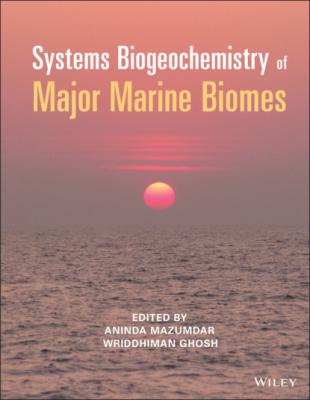Systems Biogeochemistry of Major Marine Biomes. Группа авторов
Чтение книги онлайн.
Читать онлайн книгу Systems Biogeochemistry of Major Marine Biomes - Группа авторов страница 26
 sulfide by hydrous Fe (III) oxides in seawater. Marine Chemistry 52: 1–16. https://doi.org/10.1016/0304‐4203 (95)00072‐0
sulfide by hydrous Fe (III) oxides in seawater. Marine Chemistry 52: 1–16. https://doi.org/10.1016/0304‐4203 (95)00072‐0213 Yucel, M., Konovalov, S.K., Moore, T.S. andet al. (2010). Sulfur speciation in the upper Black Sea sediments. Chemical Geology 269 (3–4): 364–375. https://doi.org/10.1016/j.chemgeo.2009.10.010
214 Zaback, D.A. and Pratt, L.M. (1992). Isotopic composition and speciation of sulfur in the Miocene Monterey Formation: reevaluation of sulfur reactions during early diagenesis in marine environments. Geochimica et Cosmochimica Acta 56 (2): 763–774. https://doi.org/10.1016/0016‐7037 (92)90096‐2
215 Zhu, M.X., Chen, K.K., Yang, G.P., et al. (2016). Sulfur and iron diagenesis in temperate unsteady sediments of the East China Sea inner shelf and a comparison with tropical mobile mud belts (MMBs). Journal of Geophysical Research: Biogeosciences 121 (11): 2811–2828. https://doi.org/10.1002/2016JG003391
2 Sedimentary Records of Present and Past Marine Sulfur Cycling
Herald Strauss
Institut für Geologie und Paläontologie, Westfälische Wilhelms‐Universität Münster, Corrensstraße 24, 48149 Münster, Germany (hstrauss@uni‐muenster.de)ORCiD code: 0000‐0003‐2639‐1225
ABSTRACT
The sulfur isotopic composition of marine sediments and sedimentary rocks reveals a wealth of information about sulfur cycling on different spatial and temporal scales. Sulfate minerals such as gypsum/anhydrite, barite or carbonate‐associated sulfate provide a temporal record of seawater evolution that reflects secular changes in the global sulfur cycle. Dissolved porewater sulfate and sulfide, but more so sedimentary iron sulfides and/or organic sulfur reveal details about the diagenetic evolution of marine sediments. Mass‐independent sulfur isotope anomalies have proven to be a prime recorder for the atmospheric oxygen abundance in the first half of Earth’s history.
2.1. INTRODUCTION
Sulfur is present in the ocean‐atmosphere system in multiple forms, ranging in oxidation states from +6 to –2. It is an essential element of life and participates in numerous microbially driven redox processes. In the modern ocean, dissolved sulfate is the most abundant form of sulfur with a concentration of 29 mM (Canfield, 2001a). Only a few oceanic basins, most prominently the Black Sea, exhibit a permanent stratification of the water body characterized by an anoxic lower part of the water column where dissolved sulfide is stable; such a water body is termed euxinic. Modern marine sediments contain dissolved sulfate and sulfide in their porewaters, the latter resulting from microbially driven sulfate reduction. Dissolved sulfide generally combines with reduced iron to form sedimentary iron sulfide (Rickard and Luther, 2007). In ancient sedimentary rocks, sulfur is most prominently present as sulfate mineral (gypsum, anhydrite, barite), as carbonate‐associated sulfate (CAS), as sedimentary iron sulfide (pyrite), or as organic‐bound sulfur.
In our quest to unravel the global sulfur cycle, stable sulfur isotopes have been successfully utilized to identify potential source(s) and (microbial) processing of sulfur in the sedimentary realm. Traditionally, evaporitic sulfate minerals (i.e. gypsum and anhydrite) were considered as recorders of seawater evolution (Holser and Kaplan, 1966; Claypool et al., 1980; Strauss, 2004). Subsequently, the analytical approach was extended to barite (Paytan et al., 2004) and carbonate‐associated sulfate (Kampschulte and Strauss, 2004). In contrast, sedimentary pyrite was generally studied to investigating the presence and temporal evolution of microbial sulfate reduction, being an ancient process of microbially driven sulfur cycling (Strauss, 1997, 1999; Canfield, 2001a; Shen et al., 2001). Only in more recent years has there been an increase in sulfur isotope studies of organic‐bound sulfur, recognizing that sulfurization of organic matter is one way of increasing the preservation of sedimentary organic matter, while also acknowledging the fact that organic‐bound sulfur reflects part of the sedimentary sulfur budget that is largely neglected in global mass balance calculations (Werne et al., 2004). In the past 20 years, the analysis of all four stable sulfur isotopes have been instrumental in reconstructing the temporal evolution of atmospheric oxygen abundance during the early part of Earth’s history, specifically defining the first major rise in atmospheric oxygen abundance some 2.3 billion years ago (Farquhar et al., 2000). Another application for such multiple sulfur isotope approach has been the differentiation of microbial processes of sulfur cycling (Johnston et al., 2005; Zerkle et al., 2009).
This review will address key aspects of the global sulfur cycle, as recorded by the sulfur isotopic composition and archived in marine sediments. Starting with the modern ocean, different aspects of sulfur cycling on different spatial and temporal scales archived in the marine sedimentary sulfur isotope record will be explored.
2.2. STABLE SULFUR ISOTOPES – A TOOL FOR RECONSTRUCTING SPATIAL AND TEMPORAL CHANGES IN SULFUR CYCLING
Sulfur has four stable isotopes, 32S, 33S, 34S, and 36S, with average natural abundances of 94.93%, 0.76%, 4.29%, 0.02%, respectively (Coplen et al., 2002). Results are commonly expressed in the delta notation, placing the ratio of the two major isotopes 32S and 34S in a sample in relation to this ratio in a reference material and normalizing it to the Vienna Canon Diablo Troilite standard (VCDT; Krouse and Coplen, 1997):
Despite early studies recording all four stable sulfur isotopes (Hulston and Thode, 1965), only the last 20 years has there been an increasing number of multiple sulfur isotope studies that also recorded the minor 33S and 36S isotopes. Acknowledging the fact that modern day physical, chemical and biologically mediated reactions are generally associated with a mass‐dependent fractionation in sulfur isotopes, these publications express their results as deviation from the calculated mass‐dependent isotope fractionation (Farquhar et al., 2000):
Early sulfur isotope measurements in marine sediments were published by, for example, Thode et al. (1949, 1953) and Szabo et al. (1950) and provided the basis for the application of sulfur isotopes in earth and life sciences.
2.3. THE MODERN MARINE REALM
Today’s ocean is the largest modern